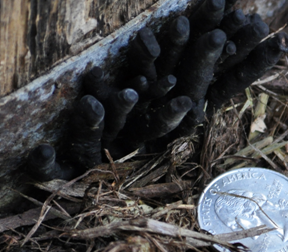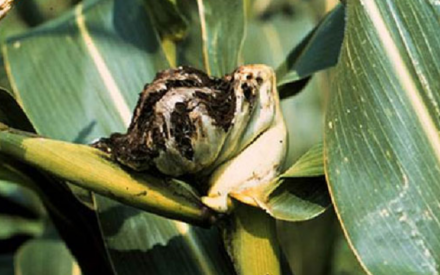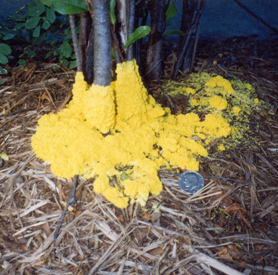
What is dead man’s fingers?
Dead man’s fingers are mushroom-like fungal growths that can be found at the base of dead or dying trees and shrubs, as well as at the base of wood objects (e.g., wood barrels) that are in contact with soil. Some types of dead man’s fingers are produced by wood-decomposing fungi. Others are produced by fungi that cause black root rot. This disease typically is a problem on stressed trees or shrubs, including apple, crabapple, pear, cherry, plum, American elm, Norway maple and honeylocust.
What does dead man’s fingers look like?
The most recognizable dead man’s fingers are those that are black and club-shaped with a white interior, appearing as solitary or clustered irregularly-shaped “fingers” that are approximately 1½ to 4 inches tall. They form on or near dead or dying wood. In the spring, as the “fingers” first form, they may be pale blue with white tips. Disease-causing species of the fungus initially form a pale sheath around roots that later becomes black and crusty, hiding a lighter interior. This sheath/crust is sometimes visible when soil is brushed away from tree/shrub roots. Trees/shrubs with above-ground symptoms of infection may show decline, dieback, slowed growth, and basal cankers. Infected apple trees may produce an abnormally large crop of smaller than normal-sized fruits.
Where does dead man’s fingers come from?
Dead man’s fingers are sexual reproductive structures of fungi in the genus Xylaria. Sexual spores (called ascospores) are produced inside each club-like “finger” and released through a tiny hole in the top. The “fingers” can release these spores for several months or years. In the spring, Xylaria can produce asexual spores (called conidia) anywhere on its surface. Xylaria also produces threadlike structures (called hyphae) that grow through dead or dying wood. Xylaria can survive as hyphae in roots for up to 10 years, and can spread from plant to plant via hyphae when plant roots come in contact with each other.
How can I save a tree with dead man’s fingers?
In urban settings, dead man’s fingers may grow from wood mulch and may not be an indication of disease. Simply remove and discard the “fingers” if you find them unsightly. If dead man’s fingers form around or near the base of an apple, crabapple or other known susceptible host, the fungus may be infecting the tree, causing black root rot. In this situation, by the time the characteristic “fingers” appear, the infection is well advanced. An infected tree should be carefully removed, including the stump and as much of the root system as possible. DO NOT use wood from Xylaria-infected trees for mulch. There are no fungicides registered in Wisconsin for treatment of black root rot.
How can I prevent dead man’s fingers from being a problem in the future?
Do not plant susceptible trees or shrubs in a site where dead man’s fingers has been observed. In addition, make sure that susceptible trees/shrubs in other locations are well watered, fertilized, mulched and otherwise maintained to reduce stresses that might predispose them to infection by disease-causing species of Xylaria. Unfortunately, Xylaria-resistant tree and shrub varieties/cultivars are not available.
For more information on dead man’s fingers:
Contact the University of Wisconsin Plant Disease Diagnostics Clinic (PDDC) at (608) 262-2863 or pddc@wisc.edu.
Authors: Ann Joy and Brian Hudelson, UW-Madison Plant Pathology
Last Revised: 02/29/2024
D-number: D0040
Thanks to Jane Anklam, Mark Kopecky and Judy Reith – Rozelle for reviewing this document.
A complete inventory of UW Plant Disease Facts is available at the University of Wisconsin-Madison Plant Disease Diagnostics Clinic website: https://pddc.wisc.edu.
Send a Plant Sample for Analysis
Be cautious when self-diagnosing plant health issues. Very few diseases can accurately be diagnosed by eye.
Contact the UW Plant Disease Diagnostics Clinic (PDDC), and for a small fee, clinic staff can examine a plant, determine the cause of the disease/disorder, and provide advice on how to control or prevent the issue.
Download Article





 Bird’s Nest Fungi
Bird’s Nest Fungi Huitlacoche
Huitlacoche Common Corn Smut
Common Corn Smut Slime Molds
Slime Molds


